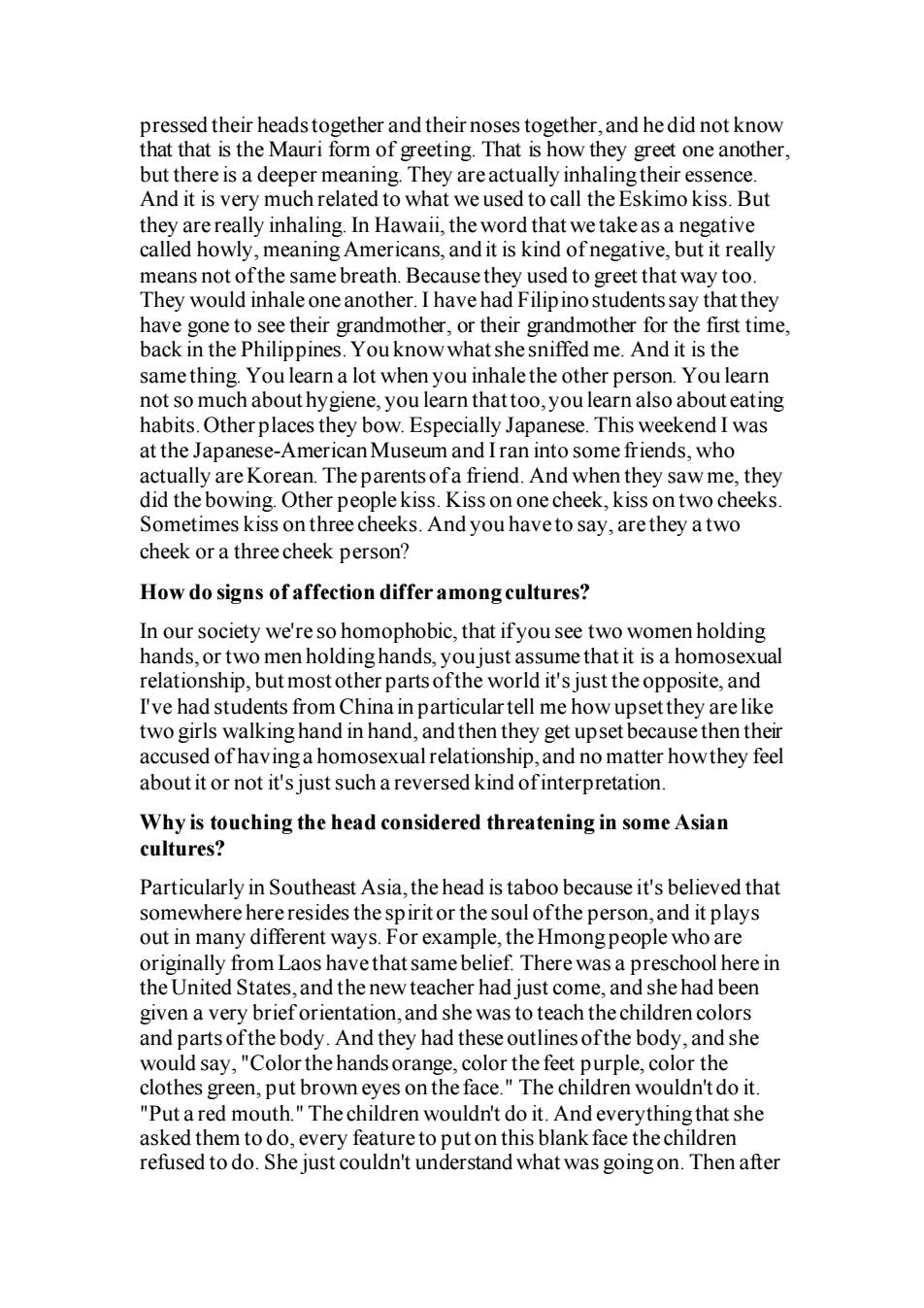正在加载图片...

y th hey gree one another but there is a deeper meaning.They are actually inhaling their essence And it is very much related to what weused to call the eskimo kiss but they are really inhaling.In Hawaii,the word that wetakeas a negative means not of the same breath.Because they used to greet that way too They would inhale one another.I have had Filipino students say that they have gone to see their grandmother,or their grandmother for the first time back in the Philippines. ou knowwhat shesniffed me.And it is the same thing.You learn a lot when you inhale the other person.You learn not so much about hygiene,you learn thattoo,you learn also about eating habits.Other places they bow.Especially Japanese.This weekend I was at the Japanese-American Museum and Iran into some friends,who actually are Korean.The parents ofa friend.And when they saw me,they did the bowing.Other people kiss.Kiss on one cheek,kiss on two cheeks Sometimes kiss on three cheeks.And you have to say,arethey a two cheek or a three cheek person? How do signs of affection differ among cultures? In our society we're so homophobic,that ifyou see two women holding hands or two men holding hands voujust assume that it is a homosexual relationship,but mostother parts ofthe world it's just the opposite,and I've had students from China in particular tell me how upset they are like two girls walking hand in hand,and then they get upset because then their accused of having a homosexual relationship,and no matter howthey feel about it or not it's just such a reversed kind ofinterpretation Why is touching the head considered threatening in some Asian res? Particularly in Southeast Asia,the head is taboo because it's believed that somewhere hereresides thespirit or the soul ofthe person,and it plays out in many different ways. For example,the Hmongpeople originally from Laos have that same belief.There was a preschool here in the United States,and the new teacher had just come,and she had been given a very brieforientation,and she was to teach the children colors and parts ofthe body.And they had these outlinesofthe body,and she would say,"Color the hands orange,color the feet purple,color the clothes green,put brown eyes on the face."The children wouldn't do it. Putgred mouth The children wouldnt dvethat she asked them to do,every feature to put on thi refused to do.She just couldn't understand what was going on.Then afterpressed their heads together and their noses together, and he did not know that that is the Mauri form of greeting. That is how they greet one another, but there is a deeper meaning. They are actually inhaling their essence. And it is very much related to what we used to call the Eskimo kiss. But they are really inhaling. In Hawaii, the word that we take as a negative called howly, meaning Americans, and it is kind of negative, but it really means not of the same breath. Because they used to greet that way too. They would inhale one another. I have had Filipino students say that they have gone to see their grandmother, or their grandmother for the first time, back in the Philippines. You know what she sniffed me. And it is the same thing. You learn a lot when you inhale the other person. You learn not so much about hygiene, you learn that too, you learn also about eating habits. Other places they bow. Especially Japanese. This weekend I was at the Japanese-American Museum and I ran into some friends, who actually are Korean. The parents of a friend. And when they saw me, they did the bowing. Other people kiss. Kiss on one cheek, kiss on two cheeks. Sometimes kiss on three cheeks. And you have to say, are they a two cheek or a three cheek person? How do signs of affection differ among cultures? In our society we're so homophobic, that if you see two women holding hands, or two men holding hands, you just assume that it is a homosexual relationship, but most other parts of the world it's just the opposite, and I've had students from China in particular tell me how upset they are like two girls walking hand in hand, and then they get upset because then their accused of having a homosexual relationship, and no matter how they feel about it or not it's just such a reversed kind of interpretation. Why is touching the head considered threatening in some Asian cultures? Particularly in Southeast Asia, the head is taboo because it's believed that somewhere here resides the spirit or the soul of the person, and it plays out in many different ways. For example, the Hmong people who are originally from Laos have that same belief. There was a preschool here in the United States, and the new teacher had just come, and she had been given a very brief orientation, and she was to teach the children colors and parts of the body. And they had these outlines of the body, and she would say, "Color the hands orange, color the feet purple, color the clothes green, put brown eyes on the face." The children wouldn't do it. "Put a red mouth." The children wouldn't do it. And everything that she asked them to do, every feature to put on this blank face the children refused to do. She just couldn't understand what was going on. Then after